- Going Viral
- Advertise with us


Public Bank launches mobile applications for planning of children’s future
- 15-03- 2022 01:45 PM

PETALING JAYA : Public Bank recently rolled out the PB Alpha Edu and the PB Journey mobile application developed with the aim at helping parents plan ahead towards providing their children with financial security.
The PB Alpha Edu, a non-participating insurance plan with investment-linked features serves as an education fund while covering death and total and permanent disability.
Distributed by Public Bank and underwritten by AIA Bhd, the plan has a maturity benefit when the child reaches age 21. Parents will appreciate the benefits of this plan where the premium paid since its inception will be harvested when their children begins their tertiary education. In the event if parents met with unfortunate events, they can prepare for such circumstances by adding the PB Education Protector Rider where their children will receive yearly income benefit while adding additional premium waiver riders will keep the PB Alpha Edu policy active without the need for premium payment for the remainder of the policy years.
The PB Journey app was designed to help parents teach their children good money habits or instill “Wisdom In Saving Early” (Wise) in a fun interactive way.
Through the learning modules, children can learn the value of money and how to be financially responsible under the guidance of their parents. They can set their financial goals and be rewarded when the goals are achieved. The earlier parents learn the advantage of teaching money management lessons to their children, the more financial savvy their children will come to be, a crucial life skill to provide for a child.
The PB Journey app, a digital banking product provides a seamless access to the Public Bank’s Wise Savings Account, which is open to all children below 18 years old with a minimum of RM1 deposit to enjoy attractive interest rates. Another new added feature targeted to be launched in the first half of this year is the DuitNow QR payment services in the PB Journey app where children can also spend and keep track of their pocket money.

Indonesia Open: Kian Meng-Pei Jing crash out in semis

Rumah setinggan enam pintu musnah dalam kebakaran di Johor Bahru

OIC strongly condemns Israeli shelling of UNRWA school housing displaced persons in Gaza

ARC 2024: Hong Kong hand Malaysia a mauling

Student group planning demo over water woes urged to think rationally
- Recommended stories

No more ‘timber politics’ in Sarawak - Abang Johari
1. indonesia open: kian meng-pei jing crash out in semis, 2. rumah setinggan enam pintu musnah dalam kebakaran di johor bahru, 3. oic strongly condemns israeli shelling of unrwa school housing displaced persons in gaza, 4. arc 2024: hong kong hand malaysia a mauling, 5. student group planning demo over water woes urged to think rationally.
Introducing Public Bank’s PB Journey Mobile Application (App), the companion App for children on their financial learning journey
What is it about?
Introducing Public Bank’s PB Journey Mobile Application (App), the companion App for children on their financial learning journey.
App Details
App screenshots.

App Store Description
Introducing Public Bank’s PB Journey Mobile Application (App), the companion App for children on their financial learning journey. This App is open to customers who maintain a WISE Savings Account with Public Bank Berhad (PBB) only. The easy to use features include: Pocket Money Children can earn pocket money by completing the tasks requested and received from parents. Goal Earn interest by saving towards a goal amount and completing it! Learning Educational videos for children to learn on financial planning. Star Achiever Programme For children to submit his/her excellent academic result for government examinations for Cash Awards. Only works under operating system iOS 10 or newer. To find out more about the App, customers are welcomed to visit any of our PBB branches, log on to PBB website at www.pbebank.com or call our customer support at +603-2179 9999 or email us at [email protected].
Share the joy of savings with your young ones
Starting early: The app assists parents in inclduing a savings habit in their children

Maintain a WISE Savings Account for your children and sign up for PB engage to start your PB Journey App adventure!
Full Article on TheStar
- View Original Article
The content is a snapshot from Publisher. Refer to the original content for accurate info. Contact us for any changes.
Related Stocks
Modal Header
Some text in the modal.
- Remember me Not recommended on shared computers
Forgot your password?
Or sign in with one of these services
- Russia, Ukraine and Belarus

Moscow Embassy
By Cali_D October 26, 2016 in Russia, Ukraine and Belarus
- Register to Reply or Ask a Question
- Go to first unread post
8 posts in this topic
Recommended posts, cali_d 43.
I had this discussion someone where else, but it applies to Moscow, so I will post this here in case someone is interested.
About Administrative Processing . Moscow embassy seem to update the satuts of the case a little different. You can track your case here: https://ceac.state.gov/CEACStatTracker/Status.aspx
Your case number will start with MOS and will be followed by several numbers. You get this case number from NVC .
If your case goes in to goes into AP before the interview, don't be worried, this is normal. Our status went from READY to AP, so I called the embassy and they told me this is normal. READY means you can schedule the Interview. Once you schedule the interview it goes to AP until the Visa is printed, Then it goes back to READY . From there, they mail it and the status goes to ISSUED .
Though, it seems this isn't happening to everyone. This is the process that was explained to us, and is what actually happened to us. Everything changed very quickly, no delays at all so far.

Link to comment
Share on other sites, kortex 0.
This is really good information. I kind of freaked out when our case switched to AP before the interview and google didn't tell me anything.
I wish I could edit my original post. Because I can't, I will add some information I posted some where else as this is a more precise description of what happens though the process in the Moscow embassy.
Contrary to popular belief EVERYONE in Moscow goes into AP, though it's usually only for a few minutes. This means 99.9% of people never see or realize they are in this status. However I write software for a living, so I wrote a script (which wasn't easy because of the captcha code) to check the status and create a log with time stamps so I see all changes, even when sleeping.
So I saw ... IN TRANSIT --> AP --> READY --> AP --> READY --> AP --> ISSUED
The first AP status (before interview) was for a day. The last AP status was just for a few minutes. Also, I called the embassy again today and they told me AP means something is about to change, passport moves from here to there, or something quick. Point is, most people don't ever see the AP status. Also I called the visa printing office in Moscow, they also told me this.
- millefleur and TBoneTX
- 2 months later...
milliron 1
My fiance Lana had her interview in Moscow on Jan. 17, and was not given a "yes" or "no", nor was she given a 221 or did they request for additional docs. They did take her passport, and said 1 to 2 weeks. Others interviewing that day were told the same. Our CEAC status reads "Administrative Processing" post interview?
millefleur 5,039
14 hours ago, milliron said: My fiance Lana had her interview in Moscow on Jan. 17, and was not given a "yes" or "no", nor was she given a 221 or did they request for additional docs. They did take her passport, and said 1 to 2 weeks. Others interviewing that day were told the same. Our CEAC status reads "Administrative Processing" post interview?
Just wait and keep checking. Most likely everything will be fine. There might be some AP post-interview, that's pretty typical. Does she have a job in tech or engineering? That can usually lead to longer AP times.
🇷🇺 CR-1 via DCF (Dec 2016-Jun 2017) & I-751 ROC (Apr 2019-Oct 2019) 🌹
Info about my DCF Moscow* experience here and here
26-Jul-2016: Married abroad in Russia 👩❤️👨 See guide here 21-Dec-2016: I-130 filed at Moscow USCIS field office* 29-Dec-2016: I-130 approved! Yay! 🎊
17-Jan-2017: Case number received
21-Mar-2017: Medical Exam completed
24-Mar-2017: Interview at Embassy - approved! 🎉
29-Mar-2017: CR-1 Visa received (via mail)
02-Apr-2017: USCIS Immigrant (GC) Fee paid
28-Jun-2017: Port of Entry @ PDX 🛩️
21-Jul-2017: No SSN after three weeks; applied in person at the SSA
22-Jul-2017: GC arrived in the mail 📬
31-Jul-2017: SSN arrived via mail, hurrah!
*NOTE: The USCIS Field Office in Moscow is now CLOSED as of February 28th, 2019.
Removal of Conditions - MSC Service Center
28-Jun-2019: Conditional GC expires
30-Mar-2019: Eligible to apply for ROC
01-Apr-2019: ROC in the mail to Phoenix AZ lockbox! 📫
03-Apr-2019: ROC packet delivered to lockbox
09-Apr-2019: USCIS cashed check
09-Apr-2019: Case number received via text - MSC 📲
12-Apr-2019: Extension letter arrives via mail
19-Apr-2019: Biometrics letter arrives via mail
30-Apr-2019: Biometrics appointment at local office
26-Jun-2019: Case ready to be scheduled for interview ⌛
04-Sep-2019: Interview was scheduled - letter to arrive in mail
09-Sep-2019: Interview letter arrived in the mail! ✉️
17-Oct-2019: Interview scheduled @ local USCIS
18-Oct-2019: Interview cancelled & notice ordered*
18-Oct-2019: Case was approved! 🎉
22-Oct-2019: Card was mailed to me 📨
23-Oct-2019: Card was picked by USPS
25-Oct-2019: 10 year GC Card received in mail 📬
*I don't understand this status because we DID have an interview!
🇺🇸 N-400 Application for Naturalization (Apr 2020-Jun 2021) 🛂
Filed during Covid-19 & moved states 1 month after filing
30-Mar-2020: N-400 early filing window opens!
01-Apr-2020: Filed N-400 online 💻
02-Apr-2020: NOA 1 - Receipt No. received online 📃
07-Apr-2020: NOA 1 - Receipt No. received via mail
05-May-2020: Moved to another state, filed AR-11 online
05-May-2020: Application transferred to another USCIS field office for review ➡️
15-May-2020: AR-11 request to change address completed
16-Jul-2020: Filed non-receipt inquiry due to never getting confirmation that case was transferred to new field office
15-Oct-2020: Received generic response to non-receipt inquiry, see full response here
10-Feb-2021: Contacted senator's office for help with USCIS
12-Feb-2021: Received canned response from senator's office that case is within processing time 😡
16-Feb-2021: Contacted other senator's office for help with USCIS - still no biometrics
19-Feb-2021: Biometrics reuse notice - canned response from other senator's office 🌐
23-Feb-2021: Interview scheduled - notice to come in the mail
25-Feb-2021: Biometrics reuse notice arrives via mail
01-Mar-2021: Interview notice letter arrives via mail ✉️
29-Mar-2021: Passed interview at local office! Oath Ceremony to be scheduled
13-Apr-2021: Oath Ceremony notice was mailed
04-May-2021: Oath Ceremony scheduled 🎆 Unable to attend due to illness
04-May-2021: Mailed request to reschedule Oath to local office
05-May-2021: "You did not attend your Oath Ceremony" - notice to come in the mail
06-May-2021: Oath Ceremony will be scheduled, date TBA
12-May-2021: Oath Ceremony re-scheduled for June 3rd, then de-scheduled same day 😡
25-May-2021: New Oath Ceremony notice was mailed
16-Jun-2021: Oath Ceremony scheduled 🎆 - DONE!!
17-Jun-2021: Certificate of Naturalization issued
🎆 Members new and old: don't forget to fill in your VJ timeline! 🎇 https://www.visajourney.com/timeline/
Thanks. She was a art major in uni. So no. I guess the other girls got their visas today. We have not received any request for additional information nor have we during this entire process.
- 2 weeks later...
Our interview was Jan. 17, and we were placed in AP, additional docs requested on 1/27 and provided on 1/29. Our status changed from "AP" to:

JSWH 262
I believe you will see very soon ISSUED and we can congratulate you and your fiancee!
Create an account or sign in to comment
You need to be a member in order to leave a comment
Create an account
Sign up for a new account in our community. It's easy!
Already have an account? Sign in here.
- Existing user? Sign In
- Immigration Guides
- Immigration Wiki
- Example Immigration Forms
- Form Downloads
- K1 Fiancé Visa
- CR1 & IR1 Spousal Visa
- US Visa FAQs
Office Reviews & Info
- Consulate & USCIS Office Reviews
- US Port of Entry Reviews
- US Consulate Information
- Processing Times
- Immigration Timelines
- VJ Partners
- Ask a Lawyer
- All Activity
- Popular Topics
- Create New...
Public Bank Berhad
Ipad & iphone.
PB engage MY
PB Sharelink Mobile App
PB enterprise
MyPB by Public Bank
PBeXperience
- Bahasa Indonesia
- Slovenščina
- Science & Tech
- Russian Kitchen
10 useful free apps to make your Moscow trip smooth and unforgettable
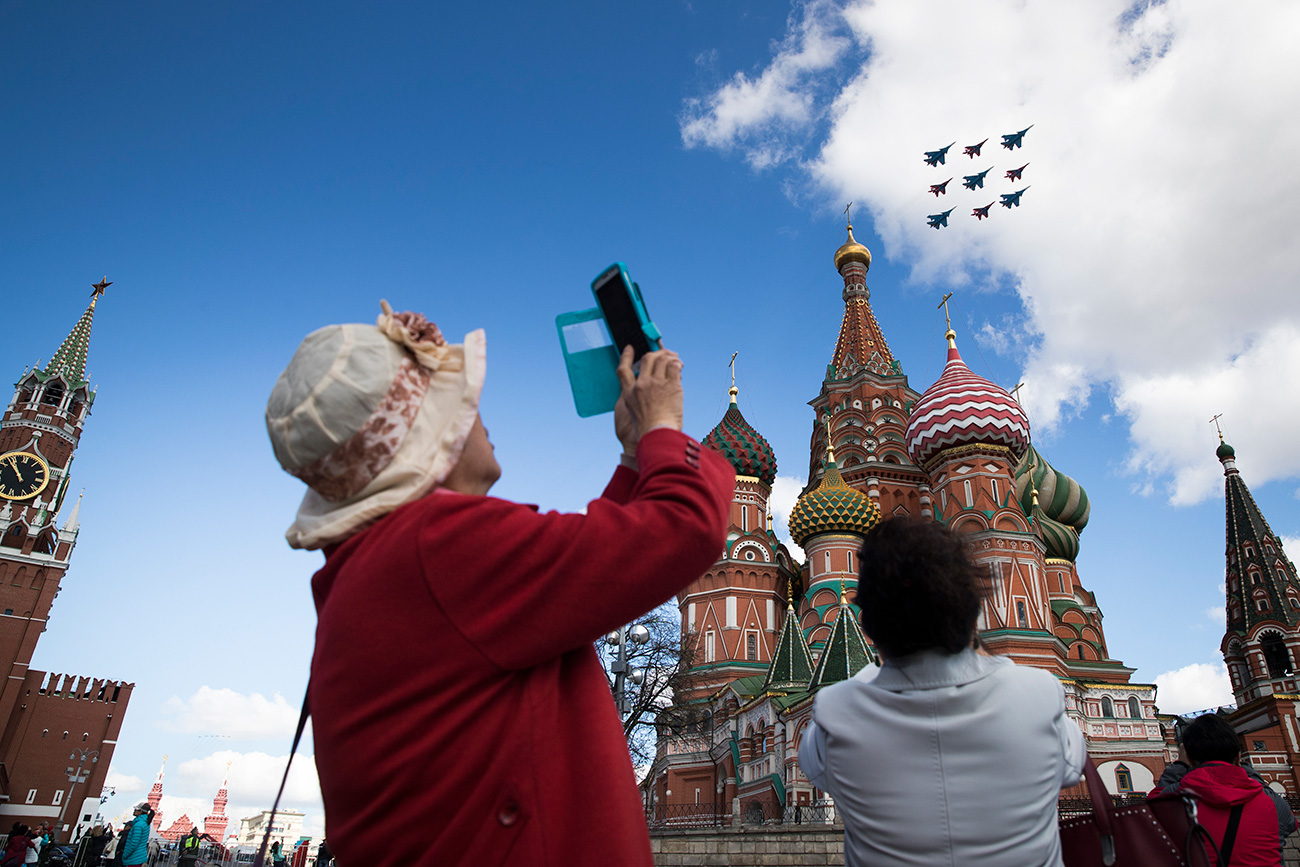
1. Getting to the city from the airport
The first thing you need to do upon arriving is to resolve the headache of how to reach the city from the airports. You can catch a fast train from each of Moscow's three main venues (Domodedovo, Sheremetyevo, Vnukovo) to the city’s central railway stations. Via the Aeroexpress app (available in English) you can check train schedules and buy tickets (420 rubles), which are valid from any of the airports at any time. By the way, the train has free Wi-Fi so this app is the only thing you need to download in advance - the rest you can load while on the tracks.
2. Catching a taxi
If you want to experience Moscow’s infamous traffic or arrive late at night, why not catch a taxi from the airport? Uber is available in Moscow, but there are also several local apps that cost about the same including Gett Taxi (works in Russian, English, and Hebrew), Yandex Taxi (many languages) and City Mobil (available in English).
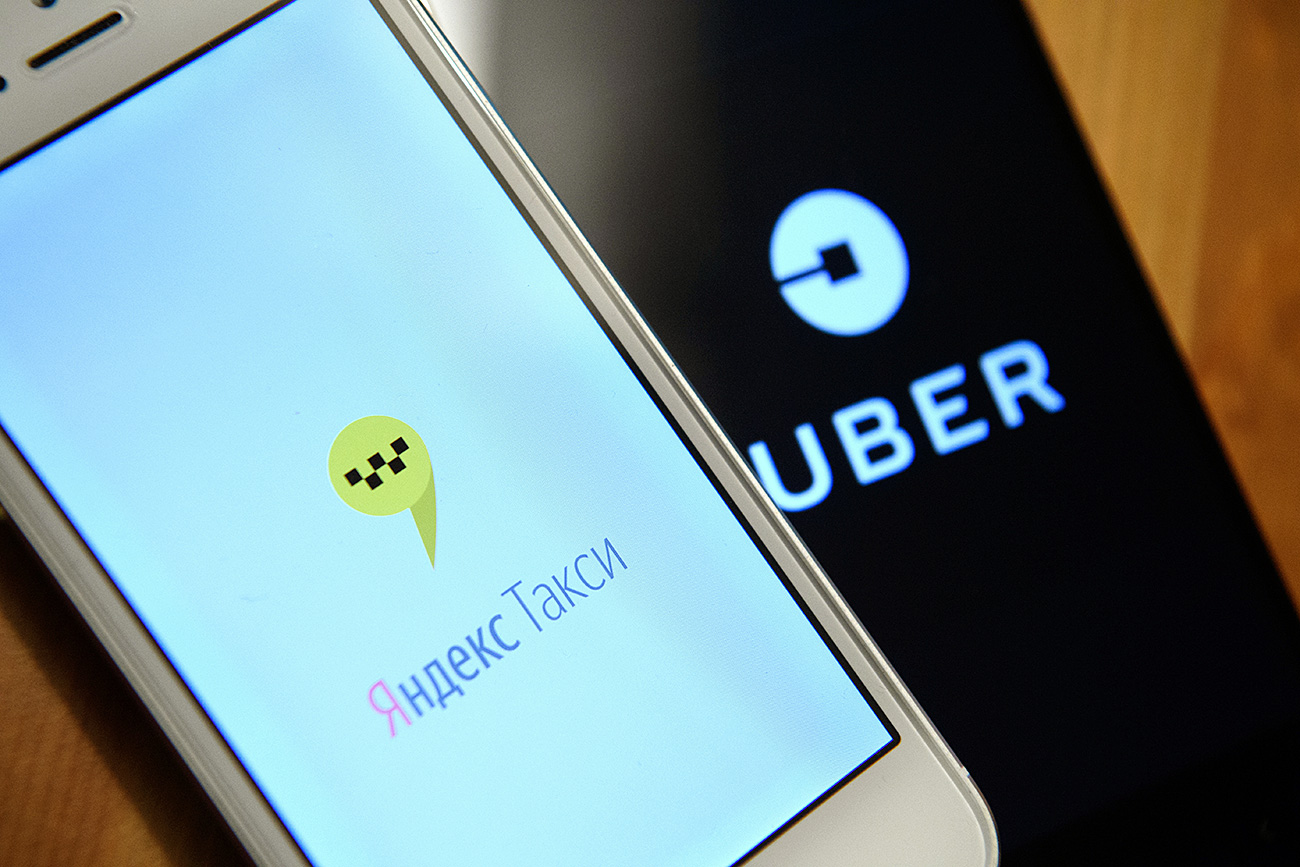
All of them are safe and waiting times are usually short. But we really advise only using them at night or if other public transport options aren’t working - getting stuck in traffic is the last thing you want after a long flight, plus it’s probably going to be more expensive.
3. On the bus and Metro
Probably the best way to discover the Metro transfer points, bus schedules, weather forecasts, and currency exchanges is to download the Yandex app (Russia’s main search engine). You’ll have a map of Moscow at your fingertips, be able to see where the traffic jams are, and view public transport moving in real time. There’s also a separate app for the Metro to make your trip even smoother (lookout for the free Wi-Fi on Moscow's underground).
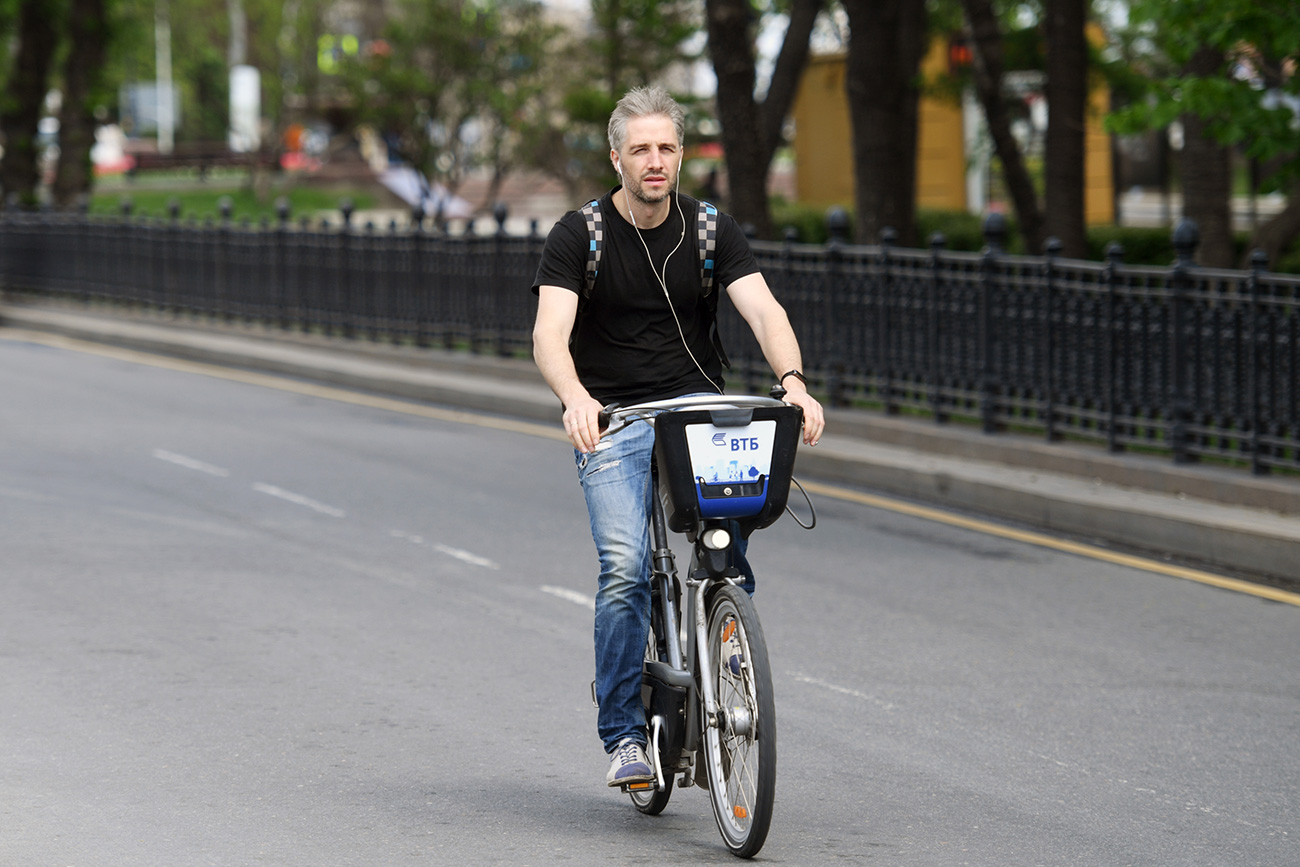
4. Renting a bike
If it's not too frosty or raining, cruising across city center on a rented bike is a great way to soak up Moscow’s sights. The city's bike infrastructure is growing and there are now many cycle paths. Check out our detailed guide>>>
To rent a public bike you should download the Velobike app . It will show you a map with all the rental points and you can pay using it. RBTH’s very own Tim Kirby shows you how in this video>>>
5. Booking a table in a restaurant
Unfortunately all the best apps and restaurant guides only work in Russian. So if you know the language we advise you to download the Afisha app . Many Russians use it to read reviews, see ratings, book tables, and buy cinema tickets. Another option is to use some global restaurant booking services (In Your Pocket, Open Table).
6. Arranging entertainment
If you want a cultural evening, to visit the theater, circus, a musical, festivals, or even sporting events, it’s a good idea to download the Ticketland app where you can buy tickets to almost all Moscow’s entertainment. You can also view schedules and show ratings.
7. Visiting a museum
While enjoying free Wi-Fi on the Metro, why not check out which museums to visit. Here’s our special guide to museum apps you should download immediately.

8. Planning a sightseeing tour
You can find all the information about the Russian capital’s tourist attractions on the Moscow Pass app . Maps and lists of museums and parks are available with historical background notes - it even works offline. But in online mode, you can book a tour of the city and buy a Moscow Pass (which opens the doors of 13 museums). It also gives you a free ride on the hop-on, hop-off bus, as well as a tour of the Moscow River.
9. Planning your Moscow and St. Petersburg tours
We know that many tourists visit Moscow and St. Petersburg for several days each, so download the PassCity app , it allows you to visit unlimited museums and use public transport for free in both cities.

10. Planning a visit to historical places outside Moscow
If you’ve already seen everything in Moscow, why not go somewhere else? We’ve written a guide to 5 of the most interesting historic places no more than two hours from Moscow, and a guide about how to get to these great locations. To see the suburban train schedules, download the Tutu app and then buy tickets in the railway station’s automatic machines (as workers of ticket offices do not always speak English).
5 stunning historical places for a day trip in the Moscow Region
Quiz: how well do you know moscow, rooms for rent: how to survive your apartment hunt in moscow, back in the ussr: 10 places to eat in moscow with soviet atmosphere, moscow will bring back gardens to the center in 2017.
If using any of Russia Beyond's content, partly or in full, always provide an active hyperlink to the original material.
to our newsletter!
Get the week's best stories straight to your inbox
This website uses cookies. Click here to find out more.
PBeXperience
A productivity tool for public bank staff to view their relevant information..
About PBeXperience
PBeXperience is a productivity tool for Public Bank staff to view their schedules, locate panel clinics and other relevant information. PBeXperience is only available for Public Bank Berhad and Public Islamic Bank Berhad staff in Malaysia. Features: • View meeting calendar • Locate nearby panel clinics • View your leave information • View upcoming events • Banking news and updates Security Quick login using Finger Print or Face ID biometrics. Device binding required for first-time login. Meeting calendar View upcoming meetings to help plan personal schedule. Panel clinic Locate nearby panel clinics using GPS or search panel clinics by clinic name and location. Links with Waze or Google/Apple Maps for navigation. Leave balance Show personal leave balance and detail by leave category. View other staff leave balance within same department/division Event Information View personalized upcoming event detail. Digital attendance taking using QR code. Banking news and updates Shows daily PBB, Fintech and Malaysian banking news. Permissions required The following permissions are required: • Access to fingerprint/Face ID for quick login. • Access to camera/photo for QR scanning. • Access to location information for nearby panel clinic. • Access to contact or navigation apps, link from panel clinic. Compatibility Android 8 and above required.
Similar Apps
PB engage MY
Welcome to our new PB engage Mobile Banking app. We’ve completely redesigned...
Introducing Public Bank’s PB Journey Mobile Application (App), the companion App for...
Introducing Public Bank's new merchant acceptance service called PBe QR. Our merchant...
PB Sharelink Mobile App
Welcome to PUBLIC BANK BERHAD’s Android Mobile Share Trading. Download the PB...
Frequently Asked Questions(FAQ)
Who can access PBeXperience?
What are the features of pbexperience, how can i login to pbexperience quickly, is device binding required for first-time login, how can i view my upcoming meetings, how can i locate nearby panel clinics, can i view my leave balance, how can i get information about upcoming events, will i get banking news and updates through pbexperience, what permissions are required for using pbexperience, what are the compatibility requirements for pbexperience.
Created with AppPage.net
Similar Apps - visible in preview.
Watch, Listen, and Learn
Your guide to the Bible's unified story. On the app, wherever you start is just the beginning.

On the BibleProject app, wherever you start is just the beginning.
Expand how you watch and listen.
From your living room to the bus stop, access the entire BibleProject library alongside interactive features found only on the app. Watch a video, listen to a podcast, and then let us show you more.
Stop Giving Up On Reading the Bible
The Bible can be difficult to figure out. We’ll help you develop skills to understand its larger story and gain confidence in reading along the way.
Do More As You Read
Learn to see patterns in the text while you’re reading. Collect Scripture links on the Torah Journey, and explore resources that will help you go deeper into your biblical study.
Explore Our Entire Video Library
Watch and listen to our entire library of videos in one place, organized by series and available for download.
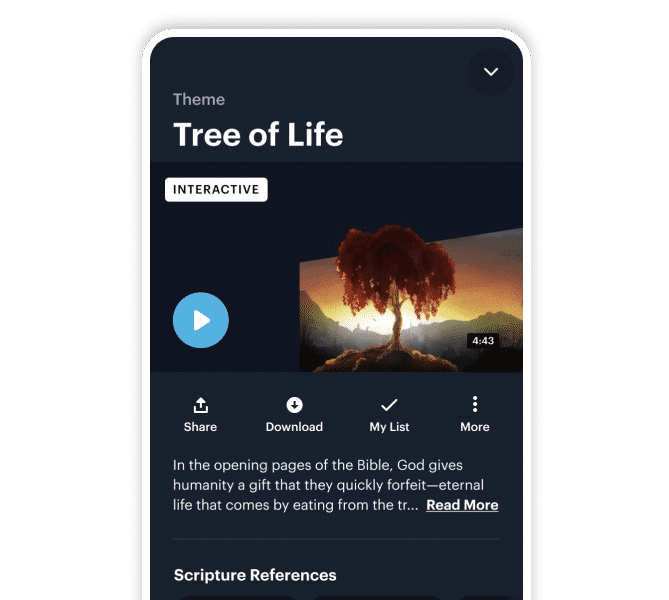
Annotated Videos
Choose a video and explore the related Scriptures and resources, including blogs, podcasts, and other videos. Start watching and then follow your Bible curiosity.
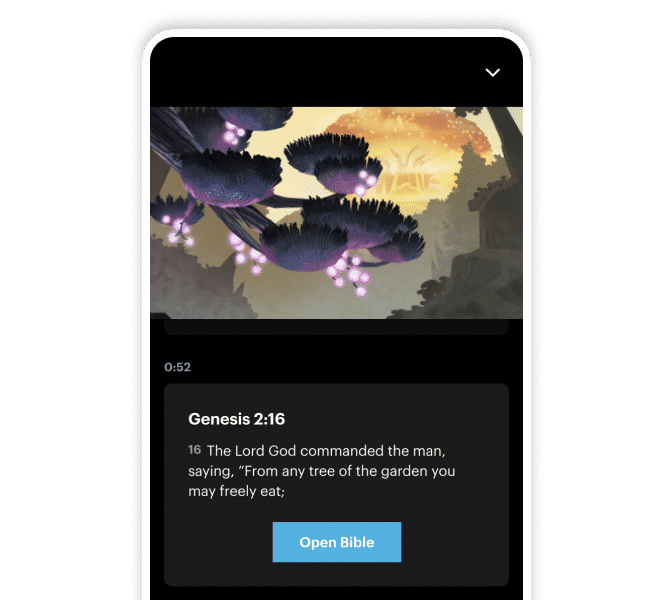
Annotated Podcasts
Experience the larger theological conversations behind our animated videos by listening to podcast episodes. Dig into interactive notes to learn more about guests, books, and all the nerdy references as you listen.
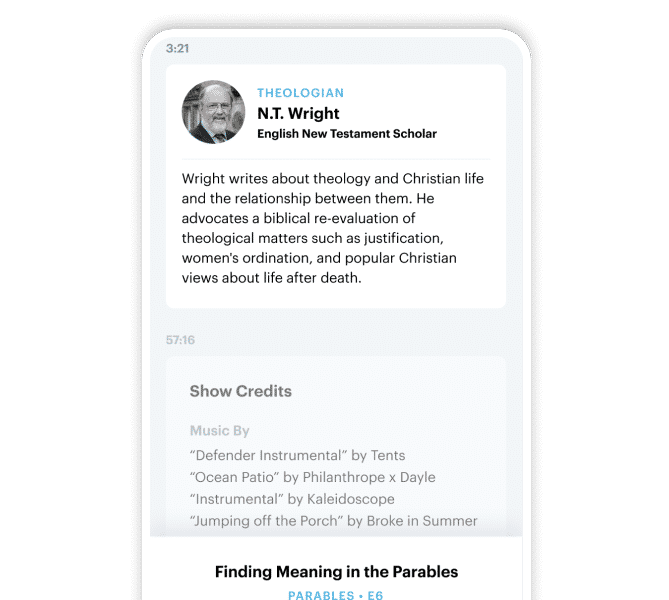
See the Big Picture With Every Read
Look up a passage and find related content in seconds with the Bible reader. See how individual passages connect to form a unified story.
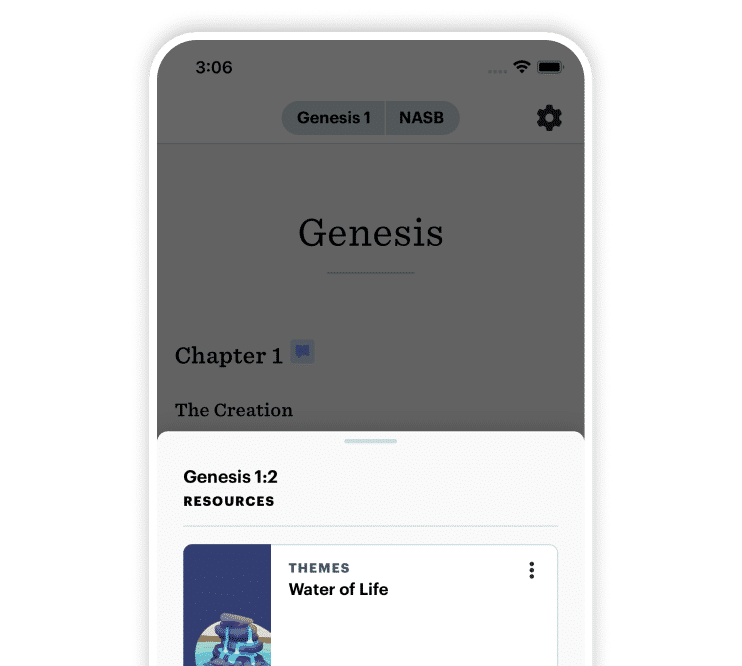
Never Lose Your Place
Save for later, download for watching offline, and see the progress you've made through the content. Easily find videos, podcasts and related resources to share with friends.
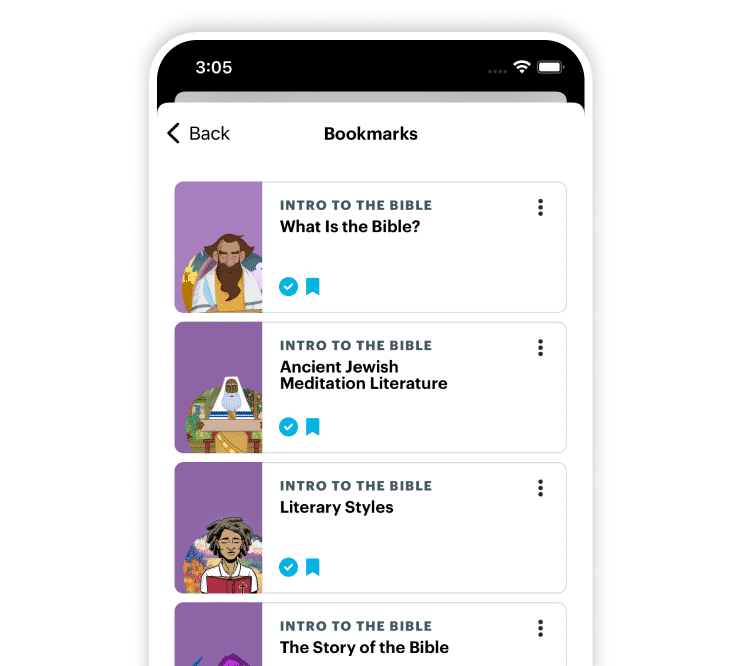
Download the BibleProject App
We’ll announce the release of fresh content throughout the year. You’re building this with us! So grab a friend, invite your community, and start the journey.

Getting Started
Journey is a great way to get started in the app. It introduces reading movements within the biblical story and will enable you to identify skills, themes, and patterns as you read.
Another way to begin is by exploring an individual video or podcast episode. We've connected and hyperlinked these materials with other related resources in our library, recommended books, and more.
The possibilities are endless! As you begin developing new skills to explore the entirety of the biblical text, you'll start to see and understand how this ancient collection of narrative, poems, prose really is a unified story that leads to Jesus.
Nope! Feel free to dive in and explore our resource library. But if you'd like to track your journey, skills, or previously explored resources, you will need to log in with an existing BibleProject account or create an account with us.
The app is currently optimized to run on iOS (14+) and Android (5+) mobile devices–and we're planning for tablet support to be introduced later this year, too.
The app contains the same library of video and podcast resources as the website but presented in a brand new way. We've created a new annotated and hyperlinked library to highlight related resources and recommended materials to help you dig deeper. The app also features our exclusive new reading experience, too.
Our website still features our entire video and podcast library. It's ideal for accessing Classroom, blogs, study notes, and other downloadable resources best viewed on larger screens.
At the moment, the app is only accessible in English, but we're working on introducing a Spanish version in the future. Stay tuned!
The Moscow Rockit
The most friendly rocket!
Yandex.Maps
Google maps
Yandex.Metro
Moscow metro, public transport.
Yandex.Trains
Aeroexpress
TripAdvisor
Triposo Moscow
Moscow Guide
GPS Audio Guide by Vokrug Sveta
Moscow travel guide, entertainment.
Timeout Moscow
Accomodation.
Food delivery
Delivery Club
Google Translate
Bing Translator
Voice Translator
Trippo Mondo
TextGrabber + Translator
MoSCoW Method: How to Make the Best of Prioritization
Prioritization played a significant role in the success of most feature-rich apps, such as Slack and GitLab . Initially, they offered a limited set of functionalities that were essential for their users. With time, this set was supplemented with other features. Railsware is going to share its own style of prioritizing and show you how we use the MoSCoW method to get long lists of tasks done.
Why do you need prioritization?
As a rule, the daily routine includes a bunch of tasks. Ideally, you’ll have enough time and energy to cover all of them – but it just might happen that the number of tasks is immense and the resources available are not in abundance. That’s where prioritization comes in.
This term denotes a process to filter what you have to do in order of importance or relevance. For example, if you’re building a house, you are not likely to begin with the roof or walls until your foundation is done. Of course, things are much more complicated in the web development industry, and this example cannot reveal the full-scope value of setting priorities.
Complex projects and numerous startups make use of advanced prioritization techniques. These usually consist of frameworks known for specific requirements or rules that improve decision-making. Success in prioritization often determines the success of the company itself. Getting caught up in pending and undone tasks is a straight road to failure. That’s why businesses pay particular attention to which prioritization methods to use. There are quite a few of them, but they all have some common characteristics, such as orientation towards input (internal or external) and quantitative or qualitative tools.
By the way, we are hiring. Check out our job openings.
External orientation means that you need to involve stakeholders outside the development team to set priorities, while the internally-oriented methods can be executed purely in-house. Quantitative methods entail a deeper focus on numeric metrics in prioritization, and the qualitative one rests on expert opinions, votings, classifications to a greater extent. In view of this, they are traditionally divided into the following categories:
You can read about different Agile prioritization techniques in detail here . If you need, we’ve also gone more in depth on what Agile product development is in a separate article.
Railsware prefers a technique developed by Dai Clegg way back in 1994. Initially, it was named MSCW, but two o’s were added to improve pronounceability. This also made it sound like the capital city of Russia. Let’s see how it works.
What is MoSCoW?
To understand the gist of the MoSCoW method, we need to look at its origin – the dynamic systems development method (DSDM). It is a framework for Agile project management tailored by practitioners with the aim of improving quality in rapid app development (RAD) processes. A hallmark of DSDM projects is strictly determined quality, costs, and time at an early stage. In view of this, all the project tasks have to be allocated by importance. The need for managing priorities triggered the invention of a specialized prioritization mechanism.
This mechanism was implemented via MoSCoW – a simple yet powerful solution to set priorities both with and without timeboxes. However, it shows better efficiency if you have a certain deadline for a task, feature, subfeature, functionality, etc. The framework is applicable to all levels of project prioritization from top to bottom, as well as to all functions and focus areas.
The MoSCoW abbreviation (except for the o’s) is carved with first letters of the priority categories it works with. These are Must-haves, Should-haves, Could-haves and Won’t-haves. And that’s how you can define which task falls into which category.
Prioritization rules
These rules or requirements estimate the importance of any task/process/feature/etc. Each company or work team uses its own approach to setting requirements, but, in general, they do not differentiate much and look as follows.
These are top-priority requirements, which shape the foundation of the major pipeline. Avoiding them means blocking the entire project or further activities. As a rule, product ideation depends entirely on defining must-haves using such pointers as ‘required for launch’, ‘required for safety’, ‘required for validation’, ‘required to deliver a viable solution’, etc.
- Can we move forward with the project if this task is undone? – if NO , it’s MUST .
Should-haves
This type of requirement is of secondary priority. Should-haves do not affect the launch and, traditionally, are considered important but not crucial. They differ from must-haves by the availability of a workaround. Therefore, the failure of a should-have task is unlikely to cause the failure of the entire project. If you’re building a product, it will still be usable even if these requirements aren’t met.
- Will we move forward with the project if this task is done a bit later? – if YES , it SHOULD .
Could-haves
The next requirement is less important than the two previous ones but still wanted. If we compare could-haves with should-haves, the former is defined by a lower degree of adverse effect if omitted. Traditionally, the third-level priority requirements in the Agile framework MoSCoW are realized if a project is not highly constrained in time. Within the product development, we can call them low-cost tweaks.
- Can we sacrifice this task till the deadline? – if YES , it’s COULD .
Won’t-haves
You can also encounter this type of requirement under the name of would-have or wish-to-have, but these variants are not recognized by the Wiki . However, regardless of the chosen name, these requirements define the lowest priority for tasks that are unviable to implement with a particular budget and deadline. Won’t-have does not mean a complete rejection of something. It envisions reintroduction under favorable conditions in the future.
- Can we get back to it when things are going better? – if YES , it’s WON’T .
In search of the perfect tools and techniques, our team often modifies some well-known approaches and tailors them to our needs. This constant search and improvement led us to brand new product ideation and decision-making framework: BRIDGeS . BRIDGeS is a flexible approach for multi-context analysis suitable for building effective product strategies, solving operational and strategic problems, making day-to-day decisions , and more. Find out how to use BRIDGeS and what advantages BRIDGeS can bring to your team .
MoSCoW is another tool that we modified to make it even more flexible and versatile. Below, we share our findings to help your team nail prioritization in a more efficient way.
How the Railsware team modified MoSCoW
The main difference between the classical MoSCoW and our version of this technique is that we added another level of prioritization within such groups as Must, Should, and Could. Each of these groups of requirements got another 4 complexity categories :
- 3 – most heavy and unclear requirements
- 2 – heavy complexity
- 1 – normal complexity
- 0 – easiest and the most urgent tasks within the group
This way, when a requirement gets, let’s say, the priority Must, we can also add a numeric matter to the letter M. For instance, our sprint can include several M2 tasks, one M1 task, and three S1 tasks.
When the task is marked with the priority “3” (M3/S3/C3), it most likely means that its scope is too large and complex to be fulfilled fast. You need to decompose it into smaller, manageable chunks and prioritize them as well. This way, from one M3 requirement, you can get a bunch of M2, S1, and C1 tasks, for example.
Sometimes, M, S, C, and W letters are not enough and we may also need an Urgent Must (UM) mark. UMs are the most critical things, such as hotfixes, bug fixes, and patches, which block the work of the whole team. From our experience, we recommend you to fix these tasks ASAP, as they hinder the team’s productive work. So if you set any task as UM, you should ignore all other tasks until the UM task is fixed. In normal situations, your bug tracking system shouldn’t have UMs.
Why do Urgent Must tasks appear? Often, UMs are the Must-haves that your team ignored before the deployment phase or missed during the QA phase. Pay attention to these tricky cases, and try to solve them before they become an obstacle.
Advantages of the modified MoSCoW approach
When we got an additional level of priorities within the MoSCoW system, we felt the following improvements:
- No need to run several rounds of task prioritization . When you have six Must-have requirements, you can’t understand which of them are the most critical or complex and run another round of prioritization. Our approach allows us to set priorities and clearly understand the importance and complexity of each task from the first round.
- Saved time . The ability to set all priorities at once saves time for all the team members who take part in the prioritization process.
- More balanced sprints. A sprint that consists only of Must-have tasks has little chance of being fulfilled. Must-haves are usually more complex requirements that guarantee the viability of a product, meaning their implementation takes more time and concentration from a developer. To dilute high-importance work with some low-hanging tasks, you can add some S0, C0, or S1 tasks to the sprint so that users get a bit more full-featured functionality of the main Must-have flows.
- More pleasant products for end users . While M3 and M2 tasks are usually crucial things necessary for the product viability, Could- and Should-haves may represent more pleasant things (changing a theme, additional filters, notifications, etc.)
How to use MoSCoW
Everything looks simple in theory, but is it in practice? Let’s check out how a traditional MoSCoW analysis of functionality prioritizing works through the example of a regular web application. As a sample, we’re going to use basic functions taken from one of the Railsware products .
List all tasks
Prioritize cards.
Based on particular requirements for budget and time, we can single out the most fundamental features to be implemented in the minimum viable product . After the priority analysis, we’ve got the following:
- A user MUST sign up.
- A user MUST log in.
- A user MUST reset password.
- A user MUST open a time-tracking page.
The top-priority tasks are followed by important, though not vital,functionalities for the app. These are:
- A user SHOULD choose the billing system.
- A user SHOULD delete an account.
- A user SHOULD choose time-tracking options.
The evolution of the app does foresee its availability on mobile devices. However, this task is only nice-to-have at this point.
- A user COULD install a mobile app version.
And now the least-priority feature. It aims at enhancing the user experience once the app is on track. Theme selectability is definitely not what we’re going to make now, so this feature is saved for later.
- A user WON’T choose the app’s visual theme THIS TIME.
Restructure cards according to their priority
This step allows you to see the quantitative ratio of high and low priority tasks.
The most difficult thing about prioritization is to be icily intelligent and focus on the essential tasks to be done. Otherwise, you can get into the EVERYTHING-IS-MUST trap , according to which any feature like the billing system option or mobile app availability turns into the must-have.
And that’s why the MoSCoW Agile method is cool. It allows you to define a basic feature set, which has top priority and emphasizes that you do not need to abandon anything. The healthy balance of must-haves + should-haves is 50% of the entire scope. All (or almost all) of the tasks will be implemented later but in the order of their importance to your goal. The goal of this example is to build an MVP , and the categorization above shows the expected progress of the app’s functionality.
How to use modified MoSCoW
We took the same example with all the tasks listed above to showcase how we apply our version of this prioritization technique.
Set priorities using the extended MoSCoW model
The main priority (Must, Should, Could, and Won’t) are still the same, however, we dived deeper to make a more precise priority estimation of each task. Here’s what we came up with:
- “A user can sign up” got an M2 mark. It is a complex task, but it’s not critically urgent.
- “A user can log in” got an M1 mark. The task is important but not that complex.
- “A user can reset password” got an M1 mark.
- “A user can choose the billing system” got an S3 mark. It’s an important feature, but its scope is large and should be split.
- “A user can delete the account” got an S2 mark.
- “A user can open a time-tracking page” got an M2 mark.
- “A user can choose time-tracking options” got an S1 mark. This is a low-hanging feature that can be taken to a sprint to balance the workload.
- “A user can install a mobile app version” got a C3 mark. This epic is too large to be implemented in one sprint. Its scope should be split into smaller tasks and prioritized as well.
- “A user can choose the app’s visual theme” got the same priority mark – Won’t, which we do not decompose.
Our modified approach provides a better understanding of the task’s priority and complexity and shows the parts that need to be reconsidered. This way, it’s easier to plan a balanced sprint, taking only tasks that can be implemented (all cards with the priority “3” should be split into smaller tasks) and some small tasks that allow your team to reduce the workload.
We have lots of knowledge to share with you. Join Railsware team.
MoSCoW pros and cons
The framework is quite popular among Agile projects with fixed timeboxes since it allows for managing the requirements for a specific release of a product. This prioritization method has proved its efficiency and reliability within our company as well, and we do recommend it to our clients. However, it is not perfect of course, and an unbiased look can reveal some flaws associated with MoSCoW technique. Let’s take a look at its strengths and weaknesses.
MoSCoW prioritization at Railsware
Let’s take a look at how we set priorities within the company.
Product development: we rest upon a roadmap where the product features and the order of their implementation are specified. As a rule, we leverage MoSCoW to define which feature goes first, which comes second, and so on, taking into account their importance and the interdependence of features. Must-haves and Should-haves are meant for the product release. Could-haves and Won’t-haves are postponed for the future.
HR and recruitment: prioritization rests upon such requirements as the demand for particular expertise, budget availability, timebox (how urgently we need this expertise), and so on. We leverage the similar patterns of setting priorities in other focus areas including on-boarding, branding, marketing, etc.
The biggest challenge of the methodology is that all stakeholders must be familiar with enough context to estimate features correctly. Besides, stakeholders that represent different functions like sales, development, marketing have their own vision of setting priorities, which not always works towards correct prioritization. Investors usually treat all features as Must-haves from their broad-based perspective and need them done without any respect of their implementation order.
Railsware has a Holacratic organizational structure . We take advantage of collective leadership based on the RASCI model and make decisions on different things including prioritization through voting. Team members can choose from several options like really want, want and don’t want. Each option implies a particular point. The option with the biggest point total has the highest priority. For small contexts, a responsible role (team leader, project manager, etc.) can be in charge of setting priorities on his/her own.
MoSCoW alternatives you may find useful for your project
Railsware uses Agile framework MoSCoW heavily and is pleased with it. However, it does not mean that we are closed to other solutions. Besides, a good product manager must consider the key product metrics and build the prioritization according to them. So here are some other worthwhile techniques that you may benefit from.
With this framework, you can define how happy the users are with product features. The Kano Model rests on a questionnaire, which is used to learn users’ attitude to a particular feature (like, expect, dislike, neutral, etc.). Visually, the model can be expressed via a two-dimensional diagram where the vertical axis is responsible for the level of user satisfaction (from totally frustrated to incredibly happy) and the horizontal one shows either how much was invested in the feature (Investment), how well was it implemented (Implementation), or how much users benefit from it (Functionality).
Categorization of requirements includes four types that are prioritized in the following order: must-be, performance, attractive, and indifferent. Must-bes are some basic things that users generally expect. Performance (also known as One-Dimensional) requirements are the golden mean and allow you to increase the satisfaction level. Attractive requirements are those that improve user experience. These are nice-to-haves or could-haves according to MoSCoW. Indifferent ones are less prioritized and sometimes even entirely omitted.
Value vs. Complexity
This prioritization technique is one of the simplest. You can encounter it under the names of Value vs. Cost or Value vs. Effort as well. The method feels intuitive and is aimed at maximizing value delivery. Estimation of features’ importance rests upon how much effort is invested to implement them and how much value they will bring. Here is how it looks visually:
Wrapping up
The art of setting priorities shows the efficiency of your workflow. Railsware’s choice is the MoSCoW project management framework, which has made a good showing in versatile functionalities and products. However, it might be less useful for immense projects with multiple teams involved in the pipeline. We advise you to find an effective prioritization solution that fits your unique needs, and to always avoid getting caught up in countless pending tasks.

Introducing Microsoft 365 Copilot – your copilot for work
Mar 16, 2023 | Jared Spataro - CVP, AI at Work
- Share on Facebook (opens new window)
- Share on Twitter (opens new window)
- Share on LinkedIn (opens new window)

Humans are hard-wired to dream, to create, to innovate. Each of us seeks to do work that gives us purpose — to write a great novel, to make a discovery, to build strong communities, to care for the sick. The urge to connect to the core of our work lives in all of us. But today, we spend too much time consumed by the drudgery of work on tasks that zap our time, creativity and energy. To reconnect to the soul of our work, we don’t just need a better way of doing the same things. We need a whole new way to work.
Today, we are bringing the power of next-generation AI to work. Introducing Microsoft 365 Copilot — your copilot for work . It combines the power of large language models (LLMs) with your data in the Microsoft Graph and the Microsoft 365 apps to turn your words into the most powerful productivity tool on the planet.
“Today marks the next major step in the evolution of how we interact with computing, which will fundamentally change the way we work and unlock a new wave of productivity growth,” said Satya Nadella, Chairman and CEO, Microsoft. “With our new copilot for work, we’re giving people more agency and making technology more accessible through the most universal interface — natural language.”
Copilot is integrated into Microsoft 365 in two ways. It works alongside you, embedded in the Microsoft 365 apps you use every day — Word, Excel, PowerPoint, Outlook, Teams and more — to unleash creativity, unlock productivity and uplevel skills. Today we’re also announcing an entirely new experience: Business Chat . Business Chat works across the LLM, the Microsoft 365 apps, and your data — your calendar, emails, chats, documents, meetings and contacts — to do things you’ve never been able to do before. You can give it natural language prompts like “Tell my team how we updated the product strategy,” and it will generate a status update based on the morning’s meetings, emails and chat threads.
With Copilot, you’re always in control. You decide what to keep, modify or discard. Now, you can be more creative in Word, more analytical in Excel, more expressive in PowerPoint, more productive in Outlook and more collaborative in Teams.
Microsoft 365 Copilot transforms work in three ways:
Unleash creativity. With Copilot in Word, you can jump-start the creative process so you never start with a blank slate again. Copilot gives you a first draft to edit and iterate on — saving hours in writing, sourcing, and editing time. Sometimes Copilot will be right, other times usefully wrong — but it will always put you further ahead. You’re always in control as the author, driving your unique ideas forward, prompting Copilot to shorten, rewrite or give feedback. Copilot in PowerPoint helps you create beautiful presentations with a simple prompt, adding relevant content from a document you made last week or last year. And with Copilot in Excel, you can analyze trends and create professional-looking data visualizations in seconds.
Unlock productivity. We all want to focus on the 20% of our work that really matters, but 80% of our time is consumed with busywork that bogs us down. Copilot lightens the load. From summarizing long email threads to quickly drafting suggested replies, Copilot in Outlook helps you clear your inbox in minutes, not hours. And every meeting is a productive meeting with Copilot in Teams. It can summarize key discussion points — including who said what and where people are aligned and where they disagree — and suggest action items, all in real time during a meeting. And with Copilot in Power Platform, anyone can automate repetitive tasks, create chatbots and go from idea to working app in minutes.
GitHub data shows that Copilot promises to unlock productivity for everyone. Among developers who use GitHub Copilot, 88% say they are more productive, 74% say that they can focus on more satisfying work, and 77% say it helps them spend less time searching for information or examples.
But Copilot doesn’t just supercharge individual productivity. It creates a new knowledge model for every organization — harnessing the massive reservoir of data and insights that lies largely inaccessible and untapped today. Business Chat works across all your business data and apps to surface the information and insights you need from a sea of data — so knowledge flows freely across the organization, saving you valuable time searching for answers. You will be able to access Business Chat from Microsoft 365.com, from Bing when you’re signed in with your work account, or from Teams.
Uplevel skills. Copilot makes you better at what you’re good at and lets you quickly master what you’ve yet to learn. The average person uses only a handful of commands — such as “animate a slide” or “insert a table” — from the thousands available across Microsoft 365. Now, all that rich functionality is unlocked using just natural language. And this is only the beginning.
Copilot will fundamentally change how people work with AI and how AI works with people. As with any new pattern of work, there’s a learning curve — but those who embrace this new way of working will quickly gain an edge.

The Copilot System: Enterprise-ready AI
Microsoft is uniquely positioned to deliver enterprise-ready AI with the Copilot System . Copilot is more than OpenAI’s ChatGPT embedded into Microsoft 365. It’s a sophisticated processing and orchestration engine working behind the scenes to combine the power of LLMs, including GPT-4, with the Microsoft 365 apps and your business data in the Microsoft Graph — now accessible to everyone through natural language.
Grounded in your business data. AI-powered LLMs are trained on a large but limited corpus of data. The key to unlocking productivity in business lies in connecting LLMs to your business data — in a secure, compliant, privacy-preserving way. Microsoft 365 Copilot has real-time access to both your content and context in the Microsoft Graph. This means it generates answers anchored in your business content — your documents, emails, calendar, chats, meetings, contacts and other business data — and combines them with your working context — the meeting you’re in now, the email exchanges you’ve had on a topic, the chat conversations you had last week — to deliver accurate, relevant, contextual responses.
Built on Microsoft’s comprehensive approach to security, compliance and privacy. Copilot is integrated into Microsoft 365 and automatically inherits all your company’s valuable security, compliance, and privacy policies and processes. Two-factor authentication, compliance boundaries, privacy protections, and more make Copilot the AI solution you can trust.
Architected to protect tenant, group and individual data. We know data leakage is a concern for customers. Copilot LLMs are not trained on your tenant data or your prompts. Within your tenant, our time-tested permissioning model ensures that data won’t leak across user groups. And on an individual level, Copilot presents only data you can access using the same technology that we’ve been using for years to secure customer data.
Integrated into the apps millions use every day. Microsoft 365 Copilot is integrated in the productivity apps millions of people use and rely on every day for work and life — Word, Excel, PowerPoint, Outlook, Teams and more. An intuitive and consistent user experience ensures it looks, feels and behaves the same way in Teams as it does in Outlook, with a shared design language for prompts, refinements and commands.
Designed to learn new skills. Microsoft 365 Copilot’s foundational skills are a game changer for productivity: It can already create, summarize, analyze, collaborate and automate using your specific business content and context. But it doesn’t stop there. Copilot knows how to command apps (e.g., “animate this slide”) and work across apps, translating a Word document into a PowerPoint presentation. And Copilot is designed to learn new skills. For example, with Viva Sales, Copilot can learn how to connect to CRM systems of record to pull customer data — like interaction and order histories — into communications. As Copilot learns about new domains and processes, it will be able to perform even more sophisticated tasks and queries.
Committed to building responsibly
At Microsoft, we are guided by our AI principles and Responsible AI Standard and decades of research on AI, grounding and privacy-preserving machine learning. A multidisciplinary team of researchers, engineers and policy experts reviews our AI systems for potential harms and mitigations — refining training data, filtering to limit harmful content, query- and result-blocking sensitive topics, and applying Microsoft technologies like InterpretML and Fairlearn to help detect and correct data bias. We make it clear how the system makes decisions by noting limitations, linking to sources, and prompting users to review, fact-check and adjust content based on subject-matter expertise.
Moving boldly as we learn
In the months ahead, we’re bringing Copilot to all our productivity apps—Word, Excel, PowerPoint, Outlook, Teams, Viva, Power Platform, and more. We’ll share more on pricing and licensing soon. Earlier this month we announced Dynamics 365 Copilot as the world’s first AI Copilot in both CRM and ERP to bring the next-generation AI to every line of business.
Everyone deserves to find purpose and meaning in their work — and Microsoft 365 Copilot can help. To serve the unmet needs of our customers, we must move quickly and responsibly, learning as we go. We’re testing Copilot with a small group of customers to get feedback and improve our models as we scale, and we will expand to more soon.
Learn more on the Microsoft 365 blog and visit WorkLab to get expert insights on how AI will create a brighter future of work for everyone.
And for all the blogs, videos and assets related to today’s announcements, please visit our microsite .
Tags: AI , Microsoft 365 , Microsoft 365 Copilot
- Check us out on RSS
The state of AI in early 2024: Gen AI adoption spikes and starts to generate value
If 2023 was the year the world discovered generative AI (gen AI) , 2024 is the year organizations truly began using—and deriving business value from—this new technology. In the latest McKinsey Global Survey on AI, 65 percent of respondents report that their organizations are regularly using gen AI, nearly double the percentage from our previous survey just ten months ago. Respondents’ expectations for gen AI’s impact remain as high as they were last year , with three-quarters predicting that gen AI will lead to significant or disruptive change in their industries in the years ahead.
About the authors
This article is a collaborative effort by Alex Singla , Alexander Sukharevsky , Lareina Yee , and Michael Chui , with Bryce Hall , representing views from QuantumBlack, AI by McKinsey, and McKinsey Digital.
Organizations are already seeing material benefits from gen AI use, reporting both cost decreases and revenue jumps in the business units deploying the technology. The survey also provides insights into the kinds of risks presented by gen AI—most notably, inaccuracy—as well as the emerging practices of top performers to mitigate those challenges and capture value.
AI adoption surges
Interest in generative AI has also brightened the spotlight on a broader set of AI capabilities. For the past six years, AI adoption by respondents’ organizations has hovered at about 50 percent. This year, the survey finds that adoption has jumped to 72 percent (Exhibit 1). And the interest is truly global in scope. Our 2023 survey found that AI adoption did not reach 66 percent in any region; however, this year more than two-thirds of respondents in nearly every region say their organizations are using AI. 1 Organizations based in Central and South America are the exception, with 58 percent of respondents working for organizations based in Central and South America reporting AI adoption. Looking by industry, the biggest increase in adoption can be found in professional services. 2 Includes respondents working for organizations focused on human resources, legal services, management consulting, market research, R&D, tax preparation, and training.
Also, responses suggest that companies are now using AI in more parts of the business. Half of respondents say their organizations have adopted AI in two or more business functions, up from less than a third of respondents in 2023 (Exhibit 2).
Gen AI adoption is most common in the functions where it can create the most value
Most respondents now report that their organizations—and they as individuals—are using gen AI. Sixty-five percent of respondents say their organizations are regularly using gen AI in at least one business function, up from one-third last year. The average organization using gen AI is doing so in two functions, most often in marketing and sales and in product and service development—two functions in which previous research determined that gen AI adoption could generate the most value 3 “ The economic potential of generative AI: The next productivity frontier ,” McKinsey, June 14, 2023. —as well as in IT (Exhibit 3). The biggest increase from 2023 is found in marketing and sales, where reported adoption has more than doubled. Yet across functions, only two use cases, both within marketing and sales, are reported by 15 percent or more of respondents.
Gen AI also is weaving its way into respondents’ personal lives. Compared with 2023, respondents are much more likely to be using gen AI at work and even more likely to be using gen AI both at work and in their personal lives (Exhibit 4). The survey finds upticks in gen AI use across all regions, with the largest increases in Asia–Pacific and Greater China. Respondents at the highest seniority levels, meanwhile, show larger jumps in the use of gen Al tools for work and outside of work compared with their midlevel-management peers. Looking at specific industries, respondents working in energy and materials and in professional services report the largest increase in gen AI use.
Investments in gen AI and analytical AI are beginning to create value
The latest survey also shows how different industries are budgeting for gen AI. Responses suggest that, in many industries, organizations are about equally as likely to be investing more than 5 percent of their digital budgets in gen AI as they are in nongenerative, analytical-AI solutions (Exhibit 5). Yet in most industries, larger shares of respondents report that their organizations spend more than 20 percent on analytical AI than on gen AI. Looking ahead, most respondents—67 percent—expect their organizations to invest more in AI over the next three years.
Where are those investments paying off? For the first time, our latest survey explored the value created by gen AI use by business function. The function in which the largest share of respondents report seeing cost decreases is human resources. Respondents most commonly report meaningful revenue increases (of more than 5 percent) in supply chain and inventory management (Exhibit 6). For analytical AI, respondents most often report seeing cost benefits in service operations—in line with what we found last year —as well as meaningful revenue increases from AI use in marketing and sales.
Inaccuracy: The most recognized and experienced risk of gen AI use
As businesses begin to see the benefits of gen AI, they’re also recognizing the diverse risks associated with the technology. These can range from data management risks such as data privacy, bias, or intellectual property (IP) infringement to model management risks, which tend to focus on inaccurate output or lack of explainability. A third big risk category is security and incorrect use.
Respondents to the latest survey are more likely than they were last year to say their organizations consider inaccuracy and IP infringement to be relevant to their use of gen AI, and about half continue to view cybersecurity as a risk (Exhibit 7).
Conversely, respondents are less likely than they were last year to say their organizations consider workforce and labor displacement to be relevant risks and are not increasing efforts to mitigate them.
In fact, inaccuracy— which can affect use cases across the gen AI value chain , ranging from customer journeys and summarization to coding and creative content—is the only risk that respondents are significantly more likely than last year to say their organizations are actively working to mitigate.
Some organizations have already experienced negative consequences from the use of gen AI, with 44 percent of respondents saying their organizations have experienced at least one consequence (Exhibit 8). Respondents most often report inaccuracy as a risk that has affected their organizations, followed by cybersecurity and explainability.
Our previous research has found that there are several elements of governance that can help in scaling gen AI use responsibly, yet few respondents report having these risk-related practices in place. 4 “ Implementing generative AI with speed and safety ,” McKinsey Quarterly , March 13, 2024. For example, just 18 percent say their organizations have an enterprise-wide council or board with the authority to make decisions involving responsible AI governance, and only one-third say gen AI risk awareness and risk mitigation controls are required skill sets for technical talent.
Bringing gen AI capabilities to bear
The latest survey also sought to understand how, and how quickly, organizations are deploying these new gen AI tools. We have found three archetypes for implementing gen AI solutions : takers use off-the-shelf, publicly available solutions; shapers customize those tools with proprietary data and systems; and makers develop their own foundation models from scratch. 5 “ Technology’s generational moment with generative AI: A CIO and CTO guide ,” McKinsey, July 11, 2023. Across most industries, the survey results suggest that organizations are finding off-the-shelf offerings applicable to their business needs—though many are pursuing opportunities to customize models or even develop their own (Exhibit 9). About half of reported gen AI uses within respondents’ business functions are utilizing off-the-shelf, publicly available models or tools, with little or no customization. Respondents in energy and materials, technology, and media and telecommunications are more likely to report significant customization or tuning of publicly available models or developing their own proprietary models to address specific business needs.
Respondents most often report that their organizations required one to four months from the start of a project to put gen AI into production, though the time it takes varies by business function (Exhibit 10). It also depends upon the approach for acquiring those capabilities. Not surprisingly, reported uses of highly customized or proprietary models are 1.5 times more likely than off-the-shelf, publicly available models to take five months or more to implement.
Gen AI high performers are excelling despite facing challenges
Gen AI is a new technology, and organizations are still early in the journey of pursuing its opportunities and scaling it across functions. So it’s little surprise that only a small subset of respondents (46 out of 876) report that a meaningful share of their organizations’ EBIT can be attributed to their deployment of gen AI. Still, these gen AI leaders are worth examining closely. These, after all, are the early movers, who already attribute more than 10 percent of their organizations’ EBIT to their use of gen AI. Forty-two percent of these high performers say more than 20 percent of their EBIT is attributable to their use of nongenerative, analytical AI, and they span industries and regions—though most are at organizations with less than $1 billion in annual revenue. The AI-related practices at these organizations can offer guidance to those looking to create value from gen AI adoption at their own organizations.
To start, gen AI high performers are using gen AI in more business functions—an average of three functions, while others average two. They, like other organizations, are most likely to use gen AI in marketing and sales and product or service development, but they’re much more likely than others to use gen AI solutions in risk, legal, and compliance; in strategy and corporate finance; and in supply chain and inventory management. They’re more than three times as likely as others to be using gen AI in activities ranging from processing of accounting documents and risk assessment to R&D testing and pricing and promotions. While, overall, about half of reported gen AI applications within business functions are utilizing publicly available models or tools, gen AI high performers are less likely to use those off-the-shelf options than to either implement significantly customized versions of those tools or to develop their own proprietary foundation models.
What else are these high performers doing differently? For one thing, they are paying more attention to gen-AI-related risks. Perhaps because they are further along on their journeys, they are more likely than others to say their organizations have experienced every negative consequence from gen AI we asked about, from cybersecurity and personal privacy to explainability and IP infringement. Given that, they are more likely than others to report that their organizations consider those risks, as well as regulatory compliance, environmental impacts, and political stability, to be relevant to their gen AI use, and they say they take steps to mitigate more risks than others do.
Gen AI high performers are also much more likely to say their organizations follow a set of risk-related best practices (Exhibit 11). For example, they are nearly twice as likely as others to involve the legal function and embed risk reviews early on in the development of gen AI solutions—that is, to “ shift left .” They’re also much more likely than others to employ a wide range of other best practices, from strategy-related practices to those related to scaling.
In addition to experiencing the risks of gen AI adoption, high performers have encountered other challenges that can serve as warnings to others (Exhibit 12). Seventy percent say they have experienced difficulties with data, including defining processes for data governance, developing the ability to quickly integrate data into AI models, and an insufficient amount of training data, highlighting the essential role that data play in capturing value. High performers are also more likely than others to report experiencing challenges with their operating models, such as implementing agile ways of working and effective sprint performance management.
About the research
The online survey was in the field from February 22 to March 5, 2024, and garnered responses from 1,363 participants representing the full range of regions, industries, company sizes, functional specialties, and tenures. Of those respondents, 981 said their organizations had adopted AI in at least one business function, and 878 said their organizations were regularly using gen AI in at least one function. To adjust for differences in response rates, the data are weighted by the contribution of each respondent’s nation to global GDP.
Alex Singla and Alexander Sukharevsky are global coleaders of QuantumBlack, AI by McKinsey, and senior partners in McKinsey’s Chicago and London offices, respectively; Lareina Yee is a senior partner in the Bay Area office, where Michael Chui , a McKinsey Global Institute partner, is a partner; and Bryce Hall is an associate partner in the Washington, DC, office.
They wish to thank Kaitlin Noe, Larry Kanter, Mallika Jhamb, and Shinjini Srivastava for their contributions to this work.
This article was edited by Heather Hanselman, a senior editor in McKinsey’s Atlanta office.
Explore a career with us
Related articles.

Moving past gen AI’s honeymoon phase: Seven hard truths for CIOs to get from pilot to scale

A generative AI reset: Rewiring to turn potential into value in 2024

Implementing generative AI with speed and safety

IMAGES
VIDEO
COMMENTS
Introducing Public Bank's PB Journey Mobile Application (App), the companion App for children on their financial learning journey. This App is open to customers who maintain a WISE Savings Account with Public Bank Berhad (PBB) only. The easy to use features include: Pocket Money
PB Journey Mobile Application (App) - Frequently Asked Questions (FAQs) 3 11. How do parents monitor / manage their child's activity in the App? Go to "PB Journey" on the side menu bar upon login to their PB engage. In the event that the parents registered the App for more than one (1) child, parents are
Download PB Journey and enjoy it on your iPhone, iPad and iPod touch. Introducing Public Bank's PB Journey Mobile Application (App), the companion App for children on their financial learning journey. This App is open to customers who maintain a WISE Savings Account with Public Bank Berhad (PBB) only.
Revision of Terms and Conditions Governing Online and Mobile Banking Services. 17 April 2024. ... In the event that the parents registered the App for more than one (1) child, parents are able to view all children's App activities under "PB Journey" module in PB engage.
PETALING JAYA: Public Bank has launched the PB Journey mobile application to assist parents in inculcating savings habit and educating their children on financial planning. The newly launched app, which complements the PB Journey Programmes, focuses on children and parents for a start as part of the bank's priority on educating the younger generation about managing wealth.
3rd August 2021 - 2 min read. Public Bank has launched a new mobile app, the PB Journey App, aimed at helping parents to educate their children on financial planning. The app is part of the PB Journey Programmes initiative and is meant to assist parents in inculcating the savings habit in their children.
Introducing Public Bank's PB Journey Mobile Application (App), the companion App for children on their financial learning journey. This App is open to customers who maintain a WISE Savings Account with Public Bank Berhad (PBB) only. The easy to use features include: Pocket Money Children can ea…
15-03- 2022 01:45 PM. PETALING JAYA: Public Bank recently rolled out the PB Alpha Edu and the PB Journey mobile application developed with the aim at helping parents plan ahead towards providing their children with financial security. The PB Alpha Edu, a non-participating insurance plan with investment-linked features serves as an education ...
Introducing Public Bank's PB Journey Mobile Application (App), the companion App for children on their financial learning journey
MyPB App - the next generation for mobile banking by Public Bank is now here! Immerse yourself in a wholly new banking experience coupled with a variety of lifestyle services at one place. ... PB Journey. Finance You Might Also Like GXBank. Finance HLB Connect Mobile Banking App. Finance HSBC Malaysia. Finance AEON Wallet Malaysia. Finance ...
Public Bank Bhd has recently introduced a new mobile application, the PB Journey Mobile Application (PB Journey App) which aims to assist parents in inculcating a savings habit in their children and educating them on financial planning.. Maintain a WISE Savings Account for your children and sign up for PB engage to start your PB Journey App adventure!
provisions of any applications in addition to its own proprietary network. l) "PB Journey Mobile Application" or "App" means the PB Journey mobile application which is made available for download via Apple App Store, Google Play Store, Huawei App Gallery, or any other app stores that the Bank may include from time to time.
Enjoy millions of the latest Android apps, games, music, movies, TV, books, magazines & more. Anytime, anywhere, across your devices. ... PB engage MY. Public Bank Berhad. ... Public Bank Berhad. PB Journey. Public Bank Berhad. PB Sharelink Mobile App 2.0. Public Bank Berhad. PB enterprise. Public Bank Berhad. PBeXperience. Public Bank Berhad ...
who have access to PB Journey mobile application ("App")# ("Eligible Participant"). * WISE Savings Account is protected by Perbadanan Insurans Deposit Malaysia up to RM250,000 for each depositor. # The App is a non-financial mobile application launched by PBB which can be downloaded from Apple App Store, Google Play Store and HUAWEI ...
About Press Copyright Contact us Creators Advertise Developers Terms Privacy Policy & Safety How YouTube works Test new features NFL Sunday Ticket Press Copyright ...
Download: PB Journey APK (App) - Latest Version: 1.9.0 - Updated: 2022 - com.pbb.journey - Public Bank Berhad - Free - Mobile App for Android. APKCombo. ... Introducing Public Bank's PB Journey Mobile Application (App), the companion App for children on their financial learning journey.
Or sign in with one of these services. Sign in with Facebook. Sign in with Twitter
Welcome to the .NET MAUI for Beginners series where you will learn the basics of building multi-platform apps with .NET MAUI for iOS, Android, macOS, and Windows from a shared C# codebase. In this video, James breaks down what exactly .NET MAUI is, how it works, and some of the features that you need to know about when building apps with the ...
PBeXperience. Productivity. Download apps by Public Bank Berhad, including PB enterprise, MyPB by Public Bank, PB Journey and many more.
9. Planning your Moscow and St. Petersburg tours. We know that many tourists visit Moscow and St. Petersburg for several days each, so download the PassCity app, it allows you to visit unlimited ...
Introducing Public Bank's PB Journey Mobile Application (App), the companion App for... PBe QR. 0.0. Introducing Public Bank's new merchant acceptance service called PBe QR. Our merchant... PB Sharelink Mobile App. 0.0. Welcome to PUBLIC BANK BERHAD's Android Mobile Share Trading. Download the PB...
Everything we make is available for free because of a generous community of supporters. Support BibleProject. BibleProject's free app allows you to read the Bible and access an entire library of videos, podcasts and more from your mobile device or tablet. Download now.
Must have mobile apps in Moscow (2014) If you have a smartphone, you will feel much more comfortable during your journey than those who do not have such "helper". Mobile applications make our trips outrageously simple: maps, routes, points of interest, booking hotels, addresses of cafés where you meet new friends — all in your smartphone.
The framework is applicable to all levels of project prioritization from top to bottom, as well as to all functions and focus areas. The MoSCoW abbreviation (except for the o's) is carved with first letters of the priority categories it works with. These are Must-haves, Should-haves, Could-haves and Won't-haves.
Copilot is integrated into Microsoft 365 in two ways. It works alongside you, embedded in the Microsoft 365 apps you use every day — Word, Excel, PowerPoint, Outlook, Teams and more — to unleash creativity, unlock productivity and uplevel skills. Today we're also announcing an entirely new experience: Business Chat.
If 2023 was the year the world discovered generative AI (gen AI), 2024 is the year organizations truly began using—and deriving business value from—this new technology. In the latest McKinsey Global Survey on AI, 65 percent of respondents report that their organizations are regularly using gen AI, nearly double the percentage from our ...